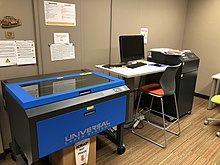Library makerspace

A library makerspace, also named Hackerspace or Hacklab, is an area and/or service that offers library patrons an opportunity to create intellectual and physical materials using resources such as computers, 3-D printers, audio and video capture and editing tools, and traditional arts and crafts supplies. In the field of library science, makerspaces are classified as a type of library service offered by librarians to patrons.
Definition[]
In a library makerspace or maker program, patrons of varying ages can work together, alone, or with library staff on creative projects. These spaces often give community members access to tools, technology, and social connections that may not be easily accessible otherwise. The goal of a makerspace is to allow patrons to learn through direct experimentation and from each other.[1] Library makerspaces do not require specified areas; a pre-existing space can be temporarily modified (or "made") to better suit the needs of participants. It is more about the intentions of the makers than about the qualities of the space itself.[2]
History[]
The force behind the initial “maker movement” is believed to be the creation of Make: magazine in 2005, which published information about maker-related projects. The momentum grew when the magazine devised a series of venues for makers to express themselves and share their creations deemed “maker faires”.[3] Libraries took notice and began offering programs and redesigning spaces to address related interests within their communities. The first public library with a maker space was the Fayetteville Free Library.[4]
Purposes[]

A library makerspace is intended to allow community members to experience technology or activities that they previously were not able to access. As many maker spaces include technology like 3D printers, sewing machines, soldering guns, coding, robotics, and wood carving machines, patrons are invited to experiment freely. The purpose of a maker space is often expressed to be inspiring an interest in science, technology, design, and lifelong learning in the people who are served by the library.[5] Over time, it is expected that the available activities within each individual maker space will grow to reflect the interests of each community in which the library is housed.[6] Makerspaces are also intended to allow minorities or underrepresented populations, like women,[5] or people with disabilities,[7] to become involved with technology and fields they may not have previously considered.[5]
Types of activities and technology[]

There are many types of makerspaces offered as a library service. They are usually developed around a certain type of medium, technology, or even patron age group. Some examples include computer programming and coding, CryptoParties, digital privacy workshops, Free Software advocacy, robotics and electronics, 3D modeling and printing, laser cutting, board games, and traditional arts and crafts.[8] Although experts in the area may be available, the community atmosphere of the space allows patrons to learn from each other and experiment rather than receive lessons.[9]
Maker spaces have also grown to allow patrons to take classes to develop a certain skill, like cooking, sewing or yoga.[10]
Criticism[]
When the concept of makerspaces in libraries was first introduced in the early 2010s, it was anticipated that some librarians would feel reluctant to allocate resources away from other services and that there could be issues of legal liability to consider.[11] Resources exist to assist libraries in making decisions about liability waivers and safety forms in addition to other potential legal concerns.[12]
See also[]
- Makerspace
- Tool library
- Fab lab
- Hackerspace
References[]
- ^ Moorefield-Lang, Heather Michele. Makers in the Library: case studies of 3d printers and maker spaces in library settings, Library Hi Tech, 2014. doi:10.1108/LHT-06-2014-0056
- ^ "From Stacks to Hacks: Makerspaces and LibraryBox". Metropolitan New York Library Council. Metropolitan New York Library Council. Archived from the original on 2 April 2015. Retrieved 1 April 2015.
- ^ "A Brief History of Makerspaces". curiositycommons. 2015-12-10. Retrieved 2018-08-20.
- ^ Clark, Melody. "Libraries & makerspaces: A revolution?". Technology and Social Change Group. University of Washington. Retrieved 1 April 2015.
- ^ Jump up to: a b c Britton, Nicole and Ward, Michael. The Makings of Maker, Library Journal, 2012
- ^ Britton, Nicole and Ward, Michael. The Makings of Maker, Library Journal, 2012.
- ^ Tara Brady, Camille Salas, Ayah Nuriddin, Walter Rodgers & Mega Subramaniam (2014) MakeAbility: Creating Accessible Makerspace Events in a Public Library, Public Library Quarterly, 33:4, 330-347, DOI: 10.1080/01616846.2014.970425
- ^ Willinghan, T. & DeBoer, J.Makerspaces in libraries, Rowman & Littlefield, 2015
- ^ 7 things you should now about Maker spaces, Edacuse, 2013
- ^ Dixon, Nicole and Ward, Michael. The Maker Movement and the Louisville Free Public Library, Accidental Press, 2014.
- ^ Diane Slatter & Zaana Howard (2013) A place to make, hack, and learn: makerspaces in Australian public libraries, The Australian Library Journal, 62:4, 272-284, DOI:10.1080/00049670.2013.853335
- ^ Minow, Mary (2016). The Library’s Legal Answers for Makerspaces. American Library Association. ISBN 9780838913901.
Further reading[]
- Mello, Maggie; Nichols, Jennifer, eds. (2020). Re-making the Library Makerspace: Critical Theories, Reflections, and Practices. Sacramento: Library Juice Press. ISBN 978-1-63400-081-9.
- Mersand, Shannon (2021). "The State of Makerspace Research: a Review of the Literature". TechTrends. 65: 174–186. doi:10.1007/s11528-020-00566-5.
External links[]
- Creativity
- DIY culture
- Hackerspaces
- Library resources
